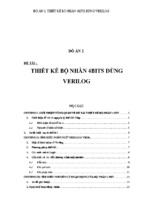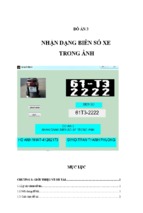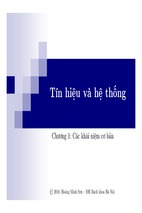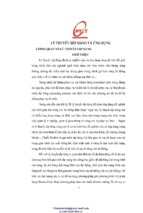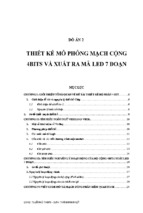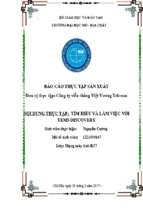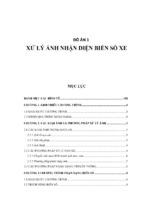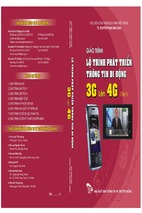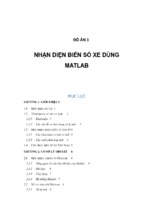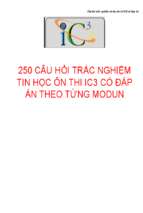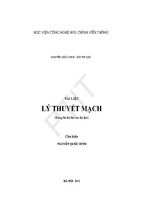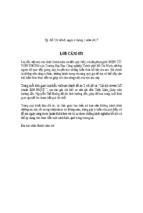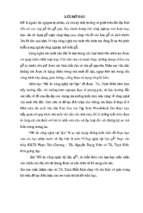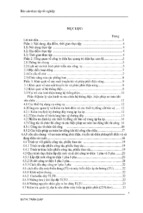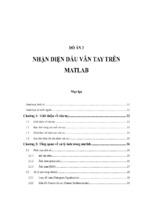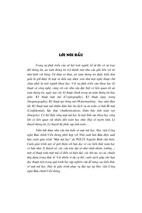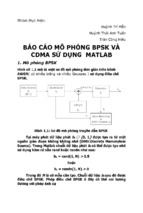Mô tả:
262001
Mobile & Wireless Networking
Lecture 3:
Medium Access Control
[Schiller, Chapter 3]
[Wikipedia: "Hybrid Automatic Repeat Request"]
Geert Heijenk
Mobile and Wireless Networking
2009 / 2010
Outline of Lecture 3
Medium Access Control
Motivation
Basic Access Methods
Dynamic TDM / Random Access
CDMA
Comparison
Hybrid ARQ
2
Mobile and Wireless Networking
2009 / 2010
Motivation
Can we apply media access methods from fixed networks?
Example CSMA/CD
Carrier Sense Multiple Access with Collision Detection
send as soon as the medium is free, listen into the medium if a
collision occurs (original method in IEEE 802.3)
Problems in wireless networks
signal strength decreases proportional to the square of the distance
the sender would apply CS and CD, but the collisions happen at the
receiver
it might be the case that a sender cannot “hear” the collision, i.e.,
CD does not work
furthermore, CS might not work if, e.g., a terminal is “hidden”
3
Mobile and Wireless Networking
2009 / 2010
Motivation - hidden and exposed terminals
Hidden terminals
A sends to B, C cannot receive A
C wants to send to B, C senses a “free” medium (CS fails)
collision at B, A cannot receive the collision (CD fails)
A is “hidden” for C
Exposed terminals
A
B
C
B sends to A, C wants to send to another terminal (not A or B)
C has to wait, CS signals a medium in use
but A is outside the radio range of C, therefore waiting is not
necessary
C is “exposed” to B
4
Mobile and Wireless Networking
2009 / 2010
Motivation - near and far terminals
Terminals A and B send, C receives
signal strength decreases proportional to the square of the distance
the signal of terminal B therefore drowns out A’s signal
C cannot receive A
A
B
C
If C for example was an arbiter for sending rights, terminal B would
drown out terminal A already on the physical layer
Also severe problem for CDMA-networks - precise power control
needed!
5
Mobile and Wireless Networking
2009 / 2010
Basic access methods
SDMA (Space Division Multiple Access)
FDMA (Frequency Division Multiple Access)
assign a certain frequency to a transmission channel between a
sender and a receiver
permanent (e.g., radio broadcast), slow hopping (e.g., GSM), fast
hopping (FHSS, Frequency Hopping Spread Spectrum)
TDMA (Time Division Multiple Access)
segment space into sectors, use directed antennas
cell structure
assign the fixed sending frequency to a transmission channel
between a sender and a receiver for a certain amount of time
CDMA (Code Division Multiple Access)
assign a code to a transmission channel between a sender and a receiver
for a certain amount of time
6
Mobile and Wireless Networking
2009 / 2010
Duplexing
Simultaneous transmission and reception of up and down-link
channels
Time and frequency domain techniques:
FDD: Frequency division duplex
TDD: Time division duplex
(Code division duplex would give an extreme near-far problem)
7
Mobile and Wireless Networking
2009 / 2010
FDD/FDMA - general scheme, example GSM
f
960 MHz
935.2 MHz
124
200 kHz
1
20 MHz
915 MHz
890.2 MHz
124
1
t
8
Mobile and Wireless Networking
2009 / 2010
TDD/TDMA - general scheme, example DECT
417 µs
1 2 3
11 12 1 2 3
downlink
11 12
uplink
t
9
Mobile and Wireless Networking
2009 / 2010
Outline of Lecture 3
Medium Access Control
Motivation
Basic Access Methods
Dynamic TDM / Random Access
CDMA
Comparison
Hybrid ARQ
10
Mobile and Wireless Networking
2009 / 2010
TDMA
Flexible
Simple receivers and transmitters
Schemes
Fixed TDM
Assigned by base station
Suitable for fixed bandwidth services
Digital mobile systems: IS-54, IS-136, GSM, DECT, PHS, PACS
Dynamic TDM (Demand oriented)
Suitable for asymmetric and or bursty services
Scheduling / polling
– Suitable for systems with central controller (e.g., base station)
Random access
– Also suitable for systems without central controller (e.g. base station)
11
Mobile and Wireless Networking
2009 / 2010
Aloha / Slotted Aloha
Mechanism
Aloha
random, distributed (no central arbiter), time-multiplex
no carrier sense, retransmission (after collision) with probability p
Slotted Aloha additionally uses time-slots, sending must always
start at slot boundaries
collision
sender A
sender B
sender C
t
Slotted Aloha
collision
sender A
sender B
sender C
t
12
Mobile and Wireless Networking
2009 / 2010
Reservations in dynamic TDM
Channel efficiency only 18% for Aloha, 36% for Slotted Aloha
(assuming Poisson distribution for packet arrivals)
Reservation can increase efficiency to 80%
a sender reserves a future time-slot
sending within this reserved time-slot is possible without collision
reservation also causes higher delays
typical scheme for satellite links
Examples for reservation algorithms:
Explicit Reservation (Reservation-ALOHA)
Implicit Reservation (PRMA)
Reservation-TDMA
13
Mobile and Wireless Networking
2009 / 2010
Explicit Reservation
Reservation Aloha / DAMA (Demand Assigned Multiple Access)
two modes:
ALOHA mode for reservation:
competition for small reservation slots, collisions possible
reserved mode for data transmission within successful reserved slots
(no collisions possible)
synchronization needed (of reserved / reservation slots)
it is important for all stations to keep the reservation list consistent at any
point in time
collision
Aloha
reserved
Aloha
reserved
Aloha
reserved
Aloha
t
14
Mobile and Wireless Networking
2009 / 2010
Implicit reservation
Packet Reservation Multiple Access (PRMA)
a certain number of slots form a frame, frames are repeated
stations compete for empty slots according to the slotted aloha principle
once a station reserves a slot successfully, this slot is automatically assigned
to this station in all following frames as long as the station has data to send
competition for this slots starts again as soon as the slot was empty in the last
frame
reservation
ACDABA-F
ACDABA-F
AC-ABAFA---BAFD
ACEEBAFD
1 2 3 4 5 6 7 8
frame1 A C D A B A
frame2 A C
time-slot
F
A B A
frame3 A
B A F
frame4 A
B A F D
frame5 A C E E B A F D
collision at
reservation
attempts
t
15
Mobile and Wireless Networking
2009 / 2010
Reservation-TDMA
Reservation Time Division Multiple Access
every frame consists of N mini-slots and x data-slots
every station has its own mini-slot and can reserve up to k data-slots using
this mini-slot (i.e. x = N * k).
other stations can send data in unused data-slots according to a round-robin
sending scheme or uncoordinated Aloha (best-effort traffic)
N mini-slots
reservations
for data-slots
N * k data-slots
e.g. N=6, k=2
other stations can use free data-slots
based on a round-robin scheme
16
Mobile and Wireless Networking
2009 / 2010
Carrier Sense Multiple Access (CSMA)
“Listen before Speak”
Not always possible:
Collision detection (“listen while speak”) does not work in
wireless:
satellite systems
hidden terminal problem
cost of collision is high (only detected after transmitting entire
packet and not receiving ack)
Try to avoid collisions:
•
•
•
non-persistent CSMA
wait random amount of time if medium is busy
p-persistent CSMA
transmit with probability p if medium is idle,
defer 1 “slot” with probability 1-p
CSMA/CA (CSMA with Collision Avoidance)
17
Mobile and Wireless Networking
2009 / 2010
CSMA/CA (CSMA with Collision Avoidance)
if medium idle:
otherwise
transmit
wait until medium becomes idle
wait until the medium is idle for a randomly taken time
(uniform from back-off window)
count-down may be suspended by transmissions of others
retransmission doubles back-off window
Used in IEEE 802.11 Wireless LAN
detailed explanation later
18
Mobile and Wireless Networking
2009 / 2010
CSMA: Dealing with hidden and exposed terminals
MACA (Multiple Access with Collision Avoidance) uses short
signaling packets for collision avoidance
Signaling packets contain
RTS (request to send): a sender request the right to send from a
receiver with a short RTS packet before it sends a data packet
CTS (clear to send): the receiver grants the right to send as soon
as it is ready to receive
sender address
receiver address
packet size
Used in IEEE 802.11 Wireless LAN (option)
19
Mobile and Wireless Networking
2009 / 2010
MACA examples
MACA avoids the problem of hidden terminals
A and C want to
send to B
A sends RTS first
C waits after receiving
CTS from B
RTS
CTS
A
CTS
B
C
MACA avoids the problem of exposed terminals
B wants to send to A, C
to another terminal
now C does not have
to wait for it cannot
receive CTS from A
RTS
RTS
CTS
A
B
C
20
Mobile and Wireless Networking
2009 / 2010
- Xem thêm -

